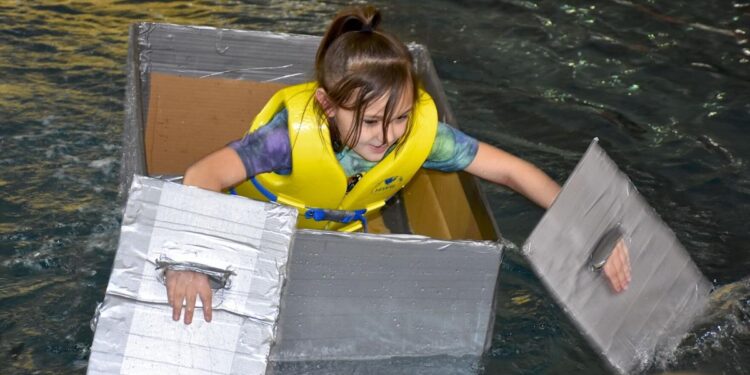Friday’s competition for the 3rd Annual Lawton Public Schools Cardboard Cup regatta could adequately be called the “future of America’s Cup.”
As students and teachers from throughout the district filtered into Fort Sill’s Rinehart Fitness Center gym Friday morning, they were ready to bring their best efforts and have a good time doing it while crafting their racing clippers for the afternoon’s race in the center’s pool.
The contest pits elementary teams from each school’s Makerspace program against each other in a friendly competition with the task of creating student-made cardboard boats and racing them across Rinehart’s 25-meter pool. It’s an extension of the collaborative elementary course allowing students to create and experiment on guided projects aligning with STEM (science, technology, engineering, and mathematics) standards, according to Vanessa Perez, Assistant Director of Educational Technology
“The LPS Cardboard Cup can help students understand many skills including natural buoyancy and surface area,” she said. “It is also a great opportunity for our students to learn STEM principles, collaborate, and apply the engineering design process.”
It wasn’t all about the racing.
There were four categories up for awards: the cardboard boat with the best time; the most aesthetic boat, the best-designed boat that doesn’t enter the water; the recycled robot boat, a smaller boat powered by a robot; and the best team logo award. This year’s theme is space through a visual and narrative, Perez said.
All contest boats were created by the students, adults are only allowed to advise, help hold down cardboard, and cut the cardboard for the students. Each site was allowed the same amount of district-supplied materials to make their boats.
Recyclable materials of cardboard donated by the LPS Internet Technology department were supplied and no more than two rolls of duct tape are allowed in the construction, according to Perez. It allows for the students to use ingenuity while working within the parameters.
“There’s a low floor and high ceiling,” she said. “The ability for the capacity for what they can learn is super high.”
Preparation began several weeks before winter break. Boat designs were tested, as was durability, Perez said. Some students had competed before and they are able to add insight from experience as to what works and what doesn’t.
Perez said it’s a great event that offers real-world problem-solving skills as well as a sense of collaboration.
The boats aren’t limited to one captain. But knowing who’s going to be at the helm is a consideration that they have to take while designing their crafts, according to Perez.
“There’s no limit to how many students can be in the boat,” she said. “They need to know who will be in the boat to establish their designs.”
When it gets down to it, Perez said, it allows the students opportunity to learn through doing.
“Every year it’s fun,” she said. “What I enjoy most is they’re not just hearing something, this is something that happened.”
When it was race time, all the team chose one captain to handle sailing the pool. There were few capsizing moments and most everyone made it from shore to shore.
The successes were found from all who took the time to compete and test their sea legs in the name of science.
Want to reach a local audience and grow your business?
Our website is the perfect platform to connect with engaged readers in your local area.
Whether you're looking for banner ads, sponsored content, or custom promotions, we can tailor a package to meet your needs.
Contact us today to learn more about advertising opportunities!
CONTACT US NOW





